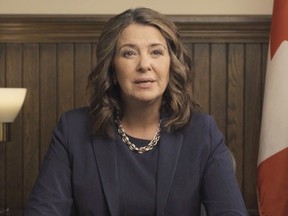
Article content
Last week, Premier Danielle Smith told Albertans what to expect in the next provincial budget, which her government will table on Thursday — essentially, that Alberta “simply cannot continue to rely” on volatile resource revenue, and that the government must restore the Alberta Heritage Fund.
Advertisement 2
Story continues below
Article content
Indeed, Alberta remains heavily reliant on volatile natural resource revenue, which includes oil and gas royalties, to maintain budget balance. In fact, if rather than being at historically high levels, resource revenue was at its average over the past two decades, the government’s $5.5-billion projected surplus in 2023-24 would immediately flip to a $4.8-billion deficit — and the government would run substantial deficits in 2024-25 and 2025-26.
Article content
The pattern of successive Alberta governments has been well documented. During times of relatively high resource revenue, the government increases spending, which becomes unsustainable (without incurring deficits) when resource revenue inevitably declines. Premier Smith plans to address this instability by restraining spending and saving resource revenue in the Heritage Fund.
Article content
Advertisement 3
Story continues below
Article content
Both of these policies would be an important step forward.
Spending restraint would more closely align ongoing spending with stable ongoing revenue (rather than temporary windfalls), which would help the province avoid deficits. And saving in the Heritage Fund would help temper the pressure to increase spending during periods of relatively high resource revenue by removing a share of resource revenue from the budget. (It would also transform a share of resource revenue into a financial asset that can accrue earnings over time.)
But the government’s success with both these policies will depend on how exactly they’re implemented.
Consider the Heritage Fund, which has been around since 1976-77. Initially, the government was required to save 30% of resource revenue — but this requirement was based in statutory law, which subsequent legislatures could easily change, and did.
Advertisement 4
Story continues below
Article content
Following a decline in resource revenue in 1982-83, the government reduced the rate to 15%. Following a second collapse of oil prices in 1986-87, it eliminated the requirement. Overall, the government made no contributions to the Heritage Fund in 32 of the 47 years from 1976-77 to 2022-23.
Put simply, governments have a bad habit of committing to policies during good times (as Alberta is currently experiencing) but quickly change course when times get tough. If the Smith government wants to truly restore the Heritage Fund, it should make the contribution requirement constitutional, which would make it much harder for the government to bend or break.
It’s possible to change Canada’s Constitution for province-specific measures. First, the Alberta government would conduct a referendum in the province asking Albertans if they agree to new terms for the Heritage Fund. If the majority of Albertans vote in favour of the proposal, the Alberta government would then pass provincial legislation to recognize the new rules and present this legislation to the federal House of Commons and Senate for recognition, resulting in a change pertaining to Alberta in the Constitution.
If a future Alberta government wanted to reverse the rule or ignore its requirements, it would need to reverse each step in this process. That’s a lot of work to undo rules meant to spare Albertans from more deficits and government debt.
The Smith government’s choices today will have big implications for Albertans moving forward. For true long-term fiscal stability, the government should implement robust fiscal rules that can’t be easily ignored or eliminated in the future.
Tegan Hill is associate director of Alberta policy at the Fraser Institute.
Article content
Comments